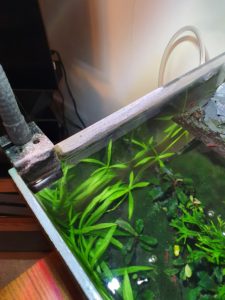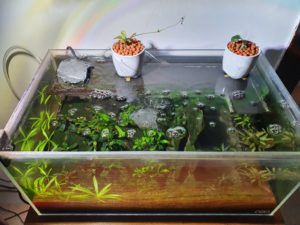
It’s been difficult with the emersed plants on the Shrimphaus shelf. Some descriptions of the tribulations below.
Growing on the slate surface directly (doesn’t work)
First I tried simply tying Chirstmas moss down in the flow on the riverbed to see if they would grab onto the river bottom, but that didn’t really work – it seems they need something for the roots to hang onto. Even though Christmas moss roots can grab onto surfaces, they didn’t do that in this context and the green parts didn’t really thrive either. I’m now growing Christmas moss completely submersed in the Shrimphaus and it seems to be doing reasonably well.
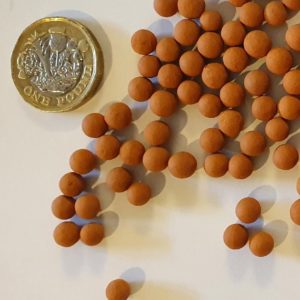
Clay balls roll away (doesn’t work)
So, this could have been obvious, but nearly perfectly spherical clay balls won’t say put in a swift-flowing water current. They all immediately washed away into the tank. Also, although these are sold as ‘hydroponic grow media’ what I was hoping for was LECA – lightweight expanded clay aggregate – which is frothed up with air holes and texture to retain water, but these clay spheres are smooth and solid and don’t seem to hold much moisture.
Lava rocks don’t stack and stay too wet (doesn’t work)
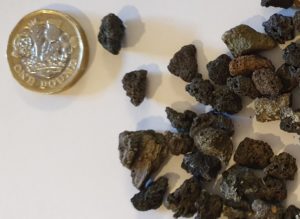
The next attempt was small pieces of irregularly shaped lava rock. The lava rock doesn’t just instantly roll away and can be successfully piled up. The odd piece does come lose and escape, but at least you can make a pile of lava rock in the current. The issue with these is that unlike the clay spheres, the lava rock stays really wet. I made as high a pile of these as I could without them falling over into the tank and the top of the pile was still completely saturated with water. I tried growing both Echinodorus grisebachii ‘Tropica’ and Anubias coffeefolia sitting on top of the lava rocks, but the wetness was rotting both of these plants and I suspect also drowning the roots. This was at least partially successful for a while as both the echinodorus and the anubias put out a few new leaves (before the rot set it) so at least there is some potential promise. I think the top of the plant needs to kept drier as do the upper parts of the roots for this to work.
Aquaponics
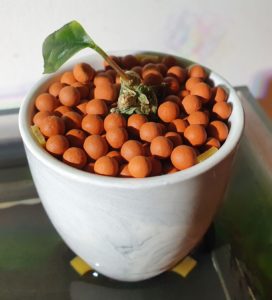
Combining an aquarium type system with a hydroponics set-up is termed ‘aquaponics‘. Since it is the emersed plant part that has been problematic I’ve been browsing literture on how to have a successful hydroponics part. There are a number of proven techniques, none of which resemble the setup on the shelf of the Shrimphaus, naturally. I’m giving a go to passive wick-system hydroponics, where inert media, in this case the clay spheres, is kept moist by the proximity of a wick that can carry water from the base of the container to the top. The wicks used here are cut up strips of an automobile synthetic chamois cloth – this part seems to be working really well. Three wicks seem to be needed to keep the clay balls reasonably moist/damp without being altogether wet. The echinodorus and anubias look pretty sad in these pots so far, but they might rally…
